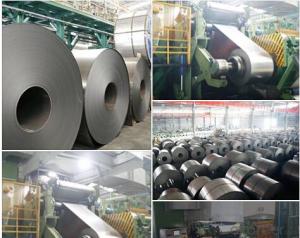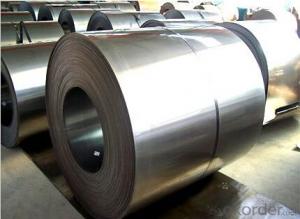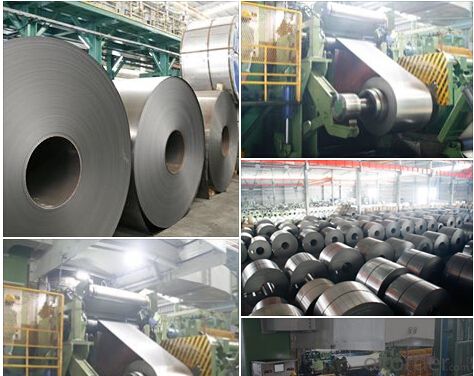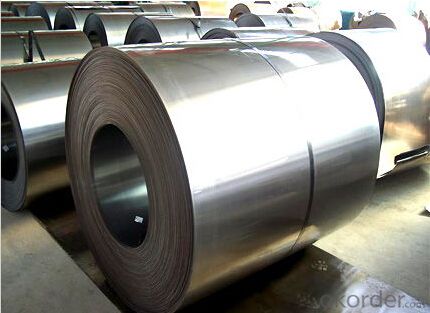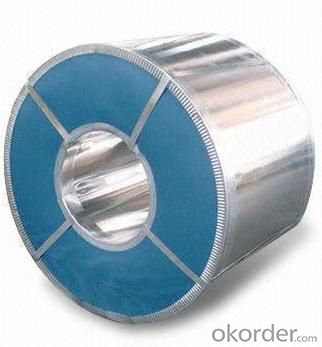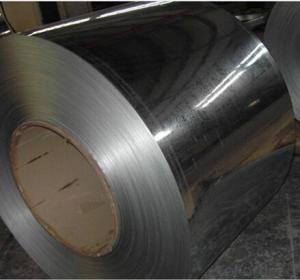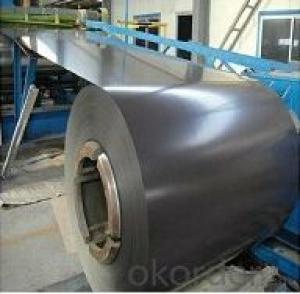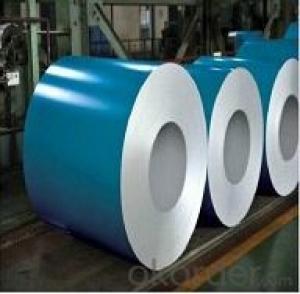Galvanized Steel (0.12-1.2mm) for Building Material
- Loading Port:
- Tianjin
- Payment Terms:
- TT OR LC
- Min Order Qty:
- 50 m.t.
- Supply Capability:
- 10000 m.t./month
OKorder Service Pledge
OKorder Financial Service
You Might Also Like
Product Details
Basic Info.
Model NO. 008
Standard:ASTM,JIS,GB,AISI,DIN,BS
Steel Grade:Q235B
Certification:ISO,SGS
Surface Treatment: Galvanized
Technique:Hot Rolled
Application:Boiler Plate
Edge:Slit edge
Stock:Stock
Size:0.12-1.2mm
Export Markets:Global
Additional Info.
Packing:standard
Standard:CE
Origin:China
Production Capacity:50000psc
Product Description
Galvanized steel coil,it is a kind of new building material and the surface with a layer electric metal zinc ,mainly have the effect of corrosion protection.
Surface electroplating a layer metal zinc steel plate of about 1 mm, both anti-corrosion effect, is widely used in the construction industry, the zinc coating of steel sheet is called galvanized sheet.Galvanized is a frequently used economic and effective anticorrosion method.
NAME: Color Coated Galvanized Steel Coil/PPGI
SIZE:
Thickness: 0.12-1.2mm
Width: 600mm-1250mm (STD914mm,1000mm, 1200mm, 1219mm, 1250mm)
Thickness tolerance: +/-0.02mm or control in 0.1 according to customer's requirement
Width tolerance: +/-2mm
JIS G 3312, ASTM A755, EN10169,GB/T2518
Base sheet: Galvanized steel coils\ Galvalume steel, such as SGCC, CGCC, DX51D+Z, Q195,etc
Base metal: Hot galvanized steel or PrePainted Galvanized aLuminium steel or HBR>85
Techinque: Cold rolled, hot-dipped galvanizing, color coated
Quality: CQ DQ prime
Commodity | Color Coated Galvanized Steel Coil/PPGI |
| Techinical Standard | ASTM, JIS, GB, AISI, DIN, BS |
| Grade | Q195 Q235 Q235B SGCC DC51D DC52D DC51D+Z |
| Thickness | 0.12-1.2mm |
| Width | 600-1250mm |
| Coil weight | 3-6tons |
| Type of coating | Galvanized |
| Zinc coating | 30-120G/M2 |
| Coil ID | 508mm or 610mm |
| MOQ | 25 MT |
| Supply capacity | 300000MT/per year |
| Package | standard sea worthy package |
| Origin | Shandong Province.China |
| Trademark | |
| Application | Industrial panels, roofing and siding for painting |
| Price terms | FOB, CFR, CIF |
| Payment terms | 30%T/T in advance+70% T/T or irrevocable 100% L/C at sight |
| delivery time | 10-20 days after recepit of 30% T/T |
| Remarks | Insurance is all risks |
Product show:
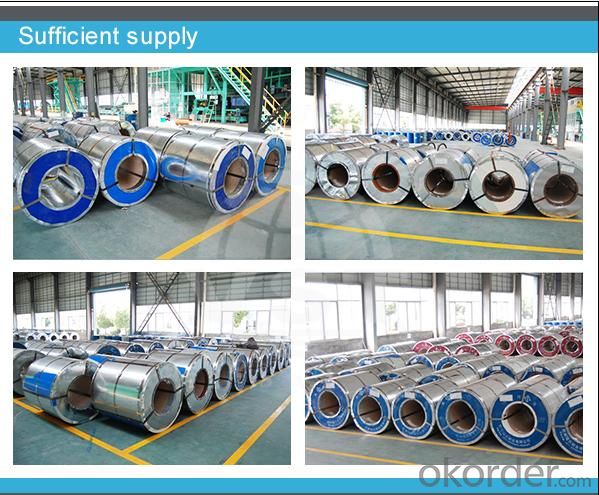

FAQ:
1. What is the minimum order quantity ?
Our MOQ is 50mt for each size. And we will consider to give more discount if you make big order like 1000 tons and more. Further more, the more appropriate payment term your offer the better price we can provide.
2. How long can we receive the product after purchase?
Usually within thirty working days after receiving buyer’s advance payment or LC. We will arrange the factory manufacturing as soon as possible. The cargo readiness usually takes 15-25 days, but the shipment will depend on the vessel situation.
3. How to guarantee the quality of the products?
We have established the international advanced quality management system,every link from raw material to final product we have strict quality test;We resolutely put an end to unqualified products flowing into the market. At the same time, we will provide necessary follow-up service assurance.
4.What is the validity of your quotation?
Normally 7 days.
5.What is your advantage?
24 hour quick response /Customer oriented/ Credit foremost/ Top quality Excellent
- Q: What are the different types of steel coil packaging machines?
- There exists a variety of steel coil packaging machines in the market, each serving a specific purpose. These machines are designed to package steel coils efficiently and effectively for storage, transportation, or distribution. Some of the available types of steel coil packaging machines are as follows: 1. Fully automated steel coil packaging machine: This machine is equipped with advanced technology and can handle large-scale packaging requirements. It wraps the steel coils with a protective layer of film or paper and can also apply strapping or stretch film to secure the coils during transportation. 2. Semi-automated steel coil packaging machine: This machine requires some manual intervention for loading and unloading the steel coils. It is suitable for medium to high-volume packaging needs and strikes a good balance between automation and cost-effectiveness. The machine typically employs a combination of wrapping, strapping, and shrinking techniques to package the coils. 3. Steel coil packaging machine with a vertical design: This machine is specifically designed for packaging vertical steel coils. It wraps the coils with a layer of film or paper and then applies strapping or stretch film to secure them. The vertical design facilitates easy loading and unloading of the coils. 4. Steel coil packaging machine with a horizontal design: This machine is ideal for packaging horizontal steel coils. It wraps the coils with a protective layer of film or paper and then applies strapping or stretch film to secure them. The horizontal design ensures convenient loading and unloading of the coils. 5. Customized steel coil packaging machine: Certain manufacturers offer customized packaging solutions tailored to specific requirements. These machines can be adjusted to accommodate different coil sizes, shapes, and packaging materials. They are designed to provide utmost flexibility and efficiency in the packaging process. To summarize, the different types of steel coil packaging machines encompass fully automated, semi-automated, vertical, horizontal, and customized machines. The selection of a suitable machine depends on factors such as packaging volume, coil orientation, and specific requirements of the steel coils being packaged.
- Q: What are the different types of steel coil coating materials?
- There are several different types of steel coil coating materials that are used in various industries and applications. Some of the most common types include: 1. Polyester: Polyester coil coating materials are known for their durability and resistance to weathering. They are often used in outdoor applications such as roofing and cladding, where they provide excellent protection against fading, chalking, and corrosion. 2. Polyvinylidene Fluoride (PVDF): PVDF coil coating materials are highly resistant to chemicals, UV radiation, and weathering. They are commonly used in architectural applications, where they provide long-lasting color retention and excellent protection against harsh environmental conditions. 3. Polyurethane: Polyurethane coil coating materials offer a high level of flexibility and adhesion, making them ideal for applications that require resistance to abrasion, impact, and bending. They are commonly used in the automotive and appliance industries. 4. Epoxy: Epoxy coil coating materials are known for their excellent adhesion and corrosion resistance. They are often used in industrial applications such as metal furniture, storage tanks, and machinery, where they provide long-lasting protection against chemicals and abrasion. 5. Silicone Modified Polyester (SMP): SMP coil coating materials combine the durability of polyester with the flexibility of silicone. They are commonly used in agricultural and industrial applications, where they provide excellent resistance to chipping, cracking, and peeling. These are just a few examples of the different types of steel coil coating materials available in the market. The choice of coating material depends on the specific requirements of the application, such as durability, weather resistance, chemical resistance, and aesthetics.
- Q: How are steel coils processed?
- Steel coils are processed through a series of steps including pickling, cold rolling, annealing, and coating to achieve desired thickness, strength, and surface finish, making them ready for various applications in industries like automotive, construction, and manufacturing.
- Q: I believe steel is stronger but it steel lighter than iron too?
- Steel is iron, with other things added that strengthen it and/or make it less rust liable. So, in general, steel is stronger than iron. In so far as the density, that depends on the steel alloy. Some are higher than iron, some lower. Remember there are hundreds of different steel alloys. edit: but the density is still close to that of iron. density steel 7750 to 8050 kg/m? density iron 7870 kg/m?
- Q: i would like to make a dmascus steel knife, i have the cable but im not sure if its damascus steel or not, how do i tell? and if it isnt damascus steel how do i make a bar of it?
- Here's what you need, the cable should be a minimum of 9/16 with large wires. You need some borax (20 mule team from the store). A good hot coal, coke, or gas forge. If the cable has fiber rope in the center it will need to be removed. Fuse the ends of the cable to keep them from coming apart. I use my welder and while I'm at it I weld a handle to make it easier. Heat it in the forge when the forge is properly heated, rotate it. Some people will burn the oil out, but I've found that the forge does that just fine. Rotate the cable while it's heating. When it begins the turn red pull it out and sprinkle the borax over it, don't hold back use a lot. It will begin to melt and bubble into the steel. Put the cable back in the forge, rotate and watch. This is the critical part. When the steel starts to turn from orange/yellow to almost yellow/white take it out and lightly (I use a 2lb hammer) begin hammering the cable into a square or rectangle. If you do it right you'll notice that it will begin to fight the hammer, that's when you know the weld it taking place. You'll have to repeat the process down the length of the cable. Once you have the billet made you can begin the process of shaping the edge and tang. Once you have it shaped, follow proper forge procedure then grind all the yuck off and finish shaping. Then harden and temper and finish it out. Good luck. I almost forgot a very important part. Befor you start hammering put the cable in a vice while at welding temp (if you are strong you can use a couple of plyers) and twist it tight. On the next heat hold the cable in your left and and lay it on the anvil. Concentrate on your light hammer blows being on your side of the cable. This forces the cable strands together. If you are using smaller cable like 9/16 you can double the cable up and weld two peices together, it is easier and makes for a prettier blade. Doing this you don't have to worry about twisting the cable and you can hit it much harder to start with.
- Q: I've heard different things bout them, though I do not know this. Oh, and if you know where you can buy some raw or get custom made stuff out of black steel please let me know it would be greatly appreciated. Oh and my friend told me there is a black steel that can be sharpened and silver will be underneath, is this also true? Thank you very much for answering ^^
- black steel and black tron are not same.
- Q: How do steel coils contribute to sound insulation in buildings?
- Steel coils can contribute to sound insulation in buildings by absorbing and reducing sound vibrations. The coils act as barriers, preventing the transmission of sound waves and minimizing noise transfer between different areas of a building.
- Q: So we all know a 1000lb steel ball will sink in water, but if you were to leave the center of the ball hollow and fill with air, if the steel ball was big enough in diameter it should float correct? What size would the steel ball need to be to float?
- Say The radius of steel ball is R. Its shell is t thick so the air filled cavity if of radius r where r = R - t Steel has a density p The mass of the ball m is given m = 4/3 pi (R^3 - r^3) p If the ball is just to float then the mass dived by the must equal the density fo water d d = m / 43/ pi R^3 Equating m in the above equations yields (r/R)^3 = (p - d)/p or r = c R where c =((p-d)/p))^1/3 Using above leads to m = 4/3 pi R^3 (1 - c^3) p and hence R can be solved for So taking p (density of steel) 490 lb/ft^3 and d (density of water) at 62 lb/ft^3 yields c= 0.9557 Applying the equation above gives R = 1.565 ft or a diameter of 37.55 in The shell thickness is R (1 - c) or 0.06938 ft or 0.8327 in Note I do all my work in metric units so I had to do some conversions on the run. I hope you will check things to make sure the maths is correct. Anyway good luck
- Q: steel of beam has been rusted ,how can i repair it?
- chrome steel is an alloy of iron and different metals, fairly Chromium and vanadium. you do no longer see it with the bare eye yet on the exterior of any chrome steel (SS) there are iron atoms and chromium atoms that are uncovered. in spite of the shown fact that, the chromium reacts preferentially to type an oxide. In essence, think of of chromium sacrificing itself for iron so as that iron won't rust. What a helpful guy huh! it somewhat is reported as passivation purely like maximum responders suggested. in spite of the shown fact that, greater desirable than that the chromium oxide varieties a good shielding layer that varieties a actual barrier combating Oxygen or any oxidant to realize and attack the iron below it. additionally, the chromium oxide shaped isn't FLAKY and porous, so it does not mar maximum of the exterior as an iron oxide (rust) would. For technology project, you won't make it too technical yet you additionally could make a reference or make an ANALOGY of rust prevention to intense college or social circumstances as being there to your pal or classmate yet in real existence, whilst the possibilities are too great, that secure practices afforded via chromium won't be adequate. because of the fact ultimately all steel uncovered to very oxidizing atmospheres will rust. in basic terms somewhat ruin in the exterior is sufficient to initiate the technique of rusting.
- Q: Are steel coils used in the oil and gas industry?
- Yes, steel coils are commonly used in the oil and gas industry for various applications. They are utilized in the manufacturing of pipelines, storage tanks, and other equipment due to their strength, durability, and resistance to corrosion. Steel coils are also employed in the construction of offshore platforms and drilling rigs, where they provide structural support and ensure the safety and reliability of the infrastructure.
Send your message to us
Galvanized Steel (0.12-1.2mm) for Building Material
- Loading Port:
- Tianjin
- Payment Terms:
- TT OR LC
- Min Order Qty:
- 50 m.t.
- Supply Capability:
- 10000 m.t./month
OKorder Service Pledge
OKorder Financial Service
Similar products
Hot products
Hot Searches
Related keywords
